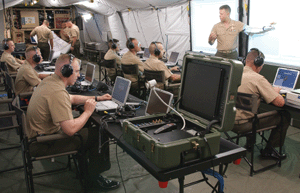From the moment fighting began in Iraq, U.S. military leaders were coolly assessing the performance of their own technology, tactics, weapons and forces. The Pentagon, in fact, had embedded an elite team of 35 joint staff officers with U.S. troops to observe operations and compile lessons learned for future wars. Despite the swift victory and many obvious successes, the team identified crucial areas where the military fell short and needs to improve technological capabilities.When troops marched into Baghdad, they were prepared for a major assault. They found only light resistance, despite intelligence expecting the contrary. The lesson: Strengthen intelligence surveillance and reconnaissance capabilities. While command centers used cutting-edge visual displays to map out theater operations, units on the field plotted their moves using paper maps and Post-it Notes. The lesson: Field units need battlespace visualization tools. While causalities were low, the inadvertent killing of friendly forces remained a problem, even after the conflict ended. On Sept. 11, soldiers from the 82nd Airborne Division killed eight members of a U.S.-funded Iraqi militia, thinking they were resistance fighters. The lesson: Improve communication among coalition forces. Field units, frustrated that all the military satellite communications bandwidth was taken, called commercial satellite providers for more connectivity -- at considerable cost. The lesson: Buy more bandwidth. [IMGCAP(2)]Army Brig. Gen. Robert Cone, director of the Joint Forces Command's Joint Center for Lessons Learned, briefed Congress on these early lessons at an Oct. 2 hearing before the House Armed Services Committee. He talked to reporters as well after the hearing.His team observed combat operations in Iraq from March 19 to May 1, when President Bush declared them over. The 35 joint staff members were embedded in units in Iraq as well as in the command centers. They conducted more than 600 interviews and spent thousands of hours determining what future missions would require. Although Cone said he was not recommending buying specific weapons or IT systems, his team's overall assessment pointed toward certain areas where the military likely will spend money to bolster its technological capabilities.In a sense, the successes of IT in the theater spurred the Pentagon to think of how else IT could be used. Bandwidth is good, but more is needed. Battlespace awareness proved its worth at the command post, so put it in the field. The services collected lots of intelligence; fuse it together through data mining and analysis tools. A coordinated assault of U.S. and coalition force packs a powerful wallop -- IT can improve coordination and bring even more bang for the buck. "We've seen tremendous potential in what these things can do, but we've got a long way to go to tie this network together and get the right information to the right guy at the right time," Cone said. Integrators have wasted no time in responding. Those with systems in the conflict found out what worked well and what needs improving. And those with pilot or prototype systems got the word on the direction their systems should be taking. SITUATIONAL AWARENESS Operation Iraqi Freedom went a long way toward validating the Pentagon's vision of network-centric warfare. Battle visualization tools proved especially effective during the conflict, according to Cone, who said the command and control facilities had some "truly very impressive digital connectivity."One of those systems, the Army's Global Command and Control System, or GCCS-A, provides a map-based representation of a theater battlespace to commanders, said Sherri Garner, director of business development for Army programs at Lockheed Martin Corp., Bethesda, Md., which supports GCCS-A. By providing a common operational picture, GCCS-A gives both joint and tactical commanders the same view of the theater.Garner recalled a March 27 incident inside the Joint Forces Commander's Operations Center at Camp Doha in Kuwait, where the GCCS-A and other command and control systems proved their worth. Army Gen. Tommy Franks, who led the effort as commander in chief of U.S. Central Command, was being briefed on the war's progress when officials were alerted that a Scud missile had been launched at targets in Kuwait. The nine displays in the room, which depicted information and data from various components of the Army's Battle Command System, all switched over to live footage of the missile. At the same time, the officers could hear the Patriot missiles being launched to intercept the incoming Scud. Franks and the other officers then watched the Patriot missiles take out the Scud, courtesy of a live video feed from a nearby unmanned aerial vehicle. But while theater operations enjoyed advanced graphical displays of the battlefield, troops often were plotting their moves and tracking the enemy the old-fashioned way, as Bing West and Ray Smith recounted in the recently published book, "The March Up: Taking Baghdad With the 1st Marine Division." The authors, who accompanied the 1st Marine Division into Iraq, noted how the units still used paper maps and Post-it Notes to plot out coordinates and make battle plans. Different field units can't get the same operational picture if they are relying on paper-based processes."It was a challenge to have the same, common operational picture," said retired Col. J.B. "Irish" Egan, the Marines' liaison and planning officer for development of Centcom's Joint Intelligence, Surveillance and Reconnaissance system. "The service intelligence systems don't directly exchange information, because they have different databases. So the Army and Marine Corps could never see what the other guy would see," he said.The planned JISR system will provide units in the field a map-based display of the friendly and enemy forces around them. JISR simplifies the data-exchange process by only extracting, rather than exchanging, information with the stovepipe intelligence systems. A Java-based client-server system feeds information to any computer on the classified network. "JISR will help leap over the challenge of systems interoperability. It will not help the systems talk to one another, but it can get the information from different systems and bring it to you," Egan said. The system is funded as a $60 million advanced concept technology demonstration for the Army and Marine Corps and is supported by Raytheon Co., Lexington, Mass. The Army 5th Corps tested JISR during Operation Iraqi Freedom. The Joint Interoperability Test Center in Fort Huachuca, Ariz., is conducting the military utility assessment of JISR.Lockheed Martin expects to find additional work in providing [IMGCAP(3)]a common operational picture system for field operations. It is adopting GCCS-A for the field, according to Curt Nutbrown, Lockheed Martin's program director for the system. In Iraq, Lockheed Martin fielded a version of the GCCS-A server that runs on a Solaris laptop, which offers the system's capabilities to workstations in the unit. The company is also testing a version of GCCS-A that can be accessed via a personal digital assistant. This will allow soldiers in the field to download information about where targets and friendly forces are in their area. Communications are encrypted and sent via the Army's classified SIPRNET, or Secret Internet Protocol Router Network, said Kenneth Wyke, software architect for Lockheed Martin. INTEROPERABILITY The conflict demonstrated the overwhelming power of joint operations, Cone said. Military commanders combined ground fire with air strikes and precision bombing to an unprecedented degree. Helping the services work more closely together will be a major thrust in future military contracts. This push for coordinated operations can be seen in the Defense Department's next-generation battle-awareness system, the Joint Command and Control system. The Army even canceled its plan to recompete GCCS-A this year, and instead will participate in its JC2 system, which is slated for award in 2006, said Lockheed's Nutbrown.The Defense Information Systems Agency, which provided the applications for GCCS-A for the services, sees JC2 as the catalyst for coordinating battlespace data from all the services into one platform, Garner said.The message to the integrators with JC2 is clear: Integrators must think about interoperability to stay in the game. Garner said Lockheed Martin will develop GCCS-A such that it will be compatible with JC2. The company also will use its GCCS-A experience to compete for JC2 work.Interoperability needs are extending beyond the U.S. military. Forty-nine countries took part in Operation Iraqi Freedom. In June, NATO stood up the Allied Command Transformation, headquartered in Norfolk, Va. This command operates in conjunction with the U.S. Joint Forces Command, said Michel Maisonneuve, transformation chief of staff for NATO. "The target is to turn alliance military capabilities into a fully integrated, joint warfighting force," Maisonneuve said.As a contractor supporting the Defense Department's Link 16 communications system for the Air Force's F-16 aircraft, Matcom International Corp. of Alexandria, Va., is aware of the challenges of joint forces interoperability, said Tom Bauer, senior vice president of international programs. Earlier this month, Bauer attended the International Data Link Symposium in England. The driving issue at the conference was interoperability between coalition forces, or the ability to get Common Data Link radios, such as Link 16, to communicate. Common Data Link is a Defense Department-defined standard for aircraft radio interoperability."The common theme is people want to play in a coalition environment and, at least for right now, if you want to play with the United States, you have to use Data Links," Bauer said. Training is the chief challenge in coalition interoperability, Bauer said. "You need maintenance training, operator training and ground training," he said. The Defense Department estimates that it takes two to five years of training to become an expert Data Link operator. [IMGCAP(4)]Achieving interoperability among coalition nations also will require more collaborative planning tools that combine military intelligence with social intelligence, said Arthur Cebrowski, director of the Defense Department's Force Transformation office. Another challenge is finding a way to bridge countries that have the advanced technologies with those that aren't as technically up to date. So an open-systems approach is essential for the future. "The challenge is how to achieve diversity without divergence," Cebrowski said at the annual meeting of the Association of the U.S. Army this month.BETTER INTELLIGENCEWhile the high quality of intelligence information was crucial to the U.S. victory, improvements are needed, Cone said. For instance, Defense Department intelligence agencies misjudged the amount of resistance that troops coming into Baghdad would encounter. "We didn't have the big fight that we thought we were going to," Cone said. "I don't think the intelligence was good at all in terms of what we thought about the enemy when we got up into Baghdad."The services also need to improve intelligence gathering after the battle, he said, noting that after a big air strike, ground troops moving through the area sometimes did not know the extent of damage or what to expect following the strikes.[IMGCAP(5)]Such intelligence also helps prevent fratricide, a major Defense Department concern. The overall number of U.S. and coalition casualties was low, but the number of victims of friendly fire were proportionally among the highest of modern conflicts, said Dennis McGinn, vice president for strategic planning for Battelle Memorial Institute, Columbus, Ohio. Cone said that although better training can reduce friendly fire, combat identification technologies should be explored.The military can strengthen intelligence by more effectively fusing field reports with analysis back in the states, said Jack London, chairman and chief executive officers of CACI International Inc., Arlington Va. London sees CACI moving further into intelligence, particularly in signal analysis, training and system support, to stay in line with the military's push to combine data from several sources for one overall picture. Battelle also sees a growing market for analysis tools that illuminate the enemy's actions. The company's six-year-old Starlight product offers a way to visualize and analyze data from disparate data sources, such as e-mail, spreadsheets and even news clippings. By showing the connections among separate pieces of data, analysts will be able to spot trends that otherwise would be difficult to pinpoint, said Brian Britzstein, program manager for Starlight. McGinn predicts that Battelle's work in advanced optical hardware and intelligence tools will enable it to win more military work as a prime contractor. BANDWIDTHThe services had 42 times the bandwidth in this conflict than in the 1991 Gulf War, Cone said. Still, it was not enough. The Defense Department is responding by beefing up bandwidth requirements for upcoming contracts.The Army and Marine Corps tactical units needed satellite communications during the war because they outran their line-of-site communications, said Mike Fallon, director of Marine Corps programs and joint programs for General Dynamics Corp.'s Decisions Systems division. In April 2002, the division won a $720 million Marine Corps contract for up to 350 mobile operations centers to be delivered by 2010. These combat operations centers provide digital maps and other graphical battlespace data for battalion and regimental ground units in the field. After Iraqi Freedom, the Marines tasked General Dynamics to integrate beyond line-of-sight communications capabilities to the centers. Such additional capabilities will allow field units to move about with greater flexibility. For the teams chasing the Warfighter Information Network-Tactical program, greater bandwidth might be a competitive factor in the final source selection process.Win-T will be a mobile, mostly wireless network for soldiers and combat vehicles to seamlessly connect into the Army's networks from anywhere. In August, the Army awarded $68 million to General Dynamics of Falls Church, Va., and $63 million to Lockheed Martin for demonstration work of the project. By 2006, the Army will pick one of these companies to roll out the operational Win-T, a $10 billion project. The amount of bandwidth an integrator's proposed Win-T solution can deliver may be a crucial element in winning the contract, said Jim Quinn, program manager for Lockheed Martin's Win-T effort. Lockheed Martin recently added wireless equipment maker Qualcomm Inc., San Diego, to its team for its advanced wireless technologies. With sufficient bandwidth, the military can enjoy the full benefits of network-enabled warfare. "Communications can challenge the chaos of the battlefield. It is crucial in terms of dominating the battlespace," said CACI's London. *Staff Writer Joab Jackson can be reached at jjackson@postnewsweektech.com.XXXSPLITXXX- $15 billion over 10 to 15 years A team led by Boeing Co. and Science Applications International Corp. won the role of lead systems integrator to develop the technology and network-centric concepts for a combat system that includes tanks and other armored vehicles that will be linked via a network. The two have been running competitions for subcontractors, and have picked 15 subcontracting teams representing more than 70 companies that will work on different design, development and testing projects for FCS. $6.9 billion over eight years Electronic Data Systems Corp. is leading an effort to connect 360,000 desktops to an integrated network with standardized software, hardware, telecommunications and security. $390 million Two unnamed contractors have won contracts, but more details, such as the length of the deals, have not been released because of security concerns. Some estimates push the value of the work closer to $1 billion. The Global Information Grid is used to collect, process, store, distribute and manage information among warfighters, policy-makers and support personnel. $9 billion over 18 years Boeing Co. is the lead systems integrator on the $2 billion, six-year design and development phase to build programmable radios that can provide voice, video and data communications. Several other procurements are being run under this program, with companies such as Harris Corp. and Rockwell Collins winning contracts. Other contracts yet to be awarded include development of airborne and maritime versions of the radios. At least $1 billion The contract falls under the Army Enterprise Infostructure Transformation program. The Army has awarded contracts to Dell Inc., GTSI Corp., Hewlett-Packard Co. and Lockheed Martin Corp. to provide hardware and software. An award is pending for contractors to provide services. This program consolidates several contracts and will allow the Army to buy end-to-end solutions and standardize its approach to networks and desktop computing. $10 billion over 15 yearsThe Army plans to build a high-speed, high-capacity network for wired and wireless voice, data and video communications for soldiers on the battlefield. Lockheed Martin Corp. and General Dynamics Corp. are each working on phase 2. They will design the system, run models and simulations of the communications network and build equipment prototypes. By 2006, the Army will pick one of the two systems integrators to build the system. $200 billion for 3,000 aircraft, with $20 billion of IT work Lockheed Martin's team will build a new fighter to replace a variety of aircraft used by the Air Force, Navy and Marine Corps. The IT portion of the work will be significant, because the military wants to incorporate network-centric elements into the fighter's systems. The British air force and navy are expected to use the aircraft as well.
General Dynamics Corp.'s Decisions Systems division is providing the Marine Corps with 350 mobile operations centers that provide digital maps and other graphical battlespace data for battalion and regimental ground units.
General Dynamics Decision systems
Army Brig. Gen. Robert Cone, director of the Joint Center for Lessons Learned, early this month outlined for Congress the capabilities the military services need.
Helene C. Stikkel/Department of Defense
Lockheed Martin, which fielded a version of its battle vizualization tool in Iraq, is now testing a version that can be accessed by PDA. The encrypted communications are sent through a classified Army network, said Kenneth Wyke, software architect for Lockheed Martin.
Olivier Douliery
The U.S. military faces the challenge of bridging the technological gap among allied forces, said Arthur Cebrowski, director of the Pentagon's Force Transformation office.
J. Adam Fenster
Dennis McGinn of Battelle sees a growing market for analysis tools, such as the company's Starlight product, that illuminate the enemy's actions.
J. Adam Fenster
The Warfighter Information Network ? TacticalValue:Purpose: Joint Strike FighterValue:Purpose:





